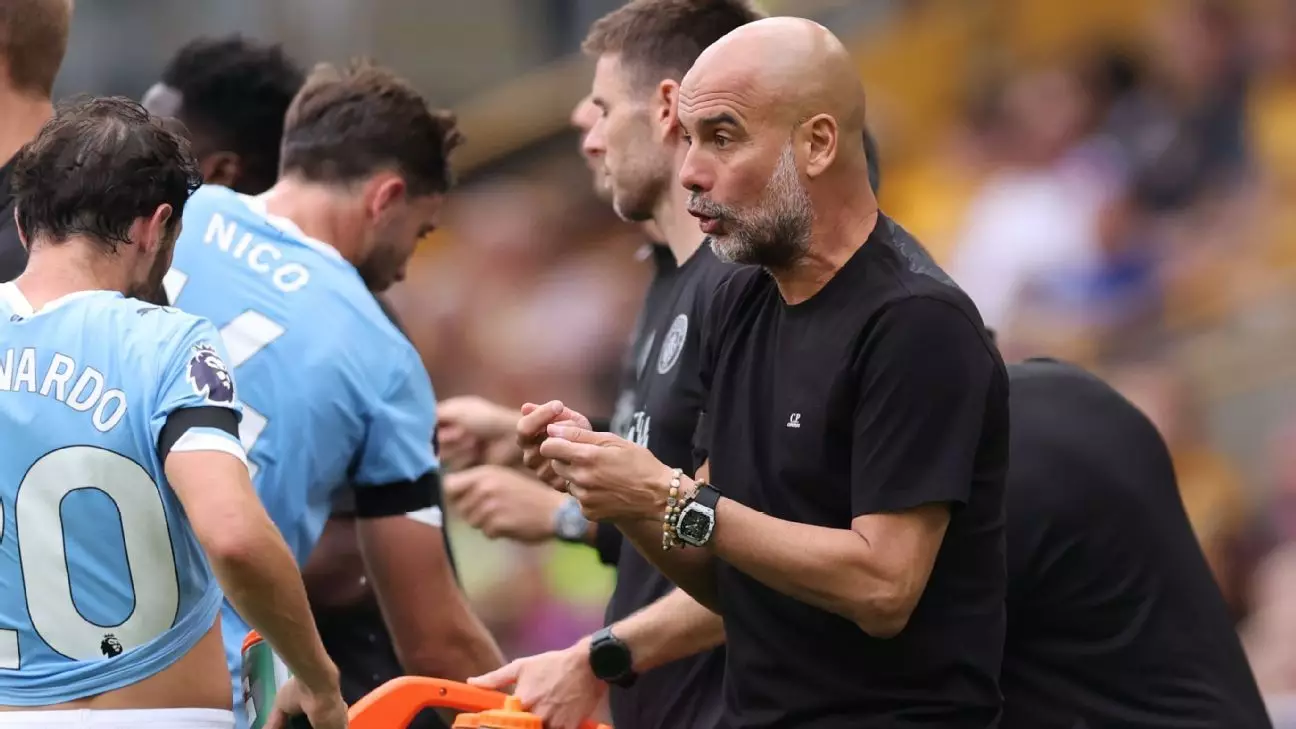Manchester City’s commanding 4-0 victory over Wolverhampton Wanderers on opening weekend was a clear statement of intent for the reigning Premier League champions. Erling Haaland’s brace, coupled with impressive contributions from newcomers Tijjani Reijnders and Rayan Cherki, showcased City’s attacking prowess and tactical flexibility. The match underlined Manchester City’s relentless pursuit of excellence, emphasizing their depth and quality. However, beneath the surface, coach Pep Guardiola’s comments reveal a brewing concern about the club’s squad management—a challenge that, if unresolved, could undermine their ambitions over the long term.
While the victory was exhilarating and the team’s quality evident, Guardiola’s remark about the squad size being “not healthy” speaks volumes about the internal imbalance looming ahead. His emphasis on maintaining a balanced, motivated dressing room echoes his philosophical approach: ensuring every player feels valued and has the opportunity to contribute. Overloading the squad with players not actively involved in matchday plans can destroy morale and disrupt harmony, ultimately impairing performance—a lesson reinforced by Guardiola’s candid critique.
This tension highlights a broader issue within elite football clubs: balancing the desire for squad depth to contend on multiple fronts with the necessity of fostering a cohesive, motivated team environment. Manchester City’s current situation illustrates that more isn’t always better, especially if it results in unresolved player frustrations or dealings that threaten team unity. For Guardiola, the key challenge lies not in acquiring talent but in managing the delicate dynamic that keeps the squad motivated and cohesive throughout a demanding season.
Squad Disquiet and the Art of Player Management
Guardiola’s revelation that the club is actively seeking solutions to offload players underscores the dilemmas faced by top managers. Although City’s squad boasts exceptional talent, there is an inherent risk in maintaining an unwieldy roster. Some players, like James McAtee, are already on the move, with a lucrative £30 million transfer to Nottingham Forest marking a pragmatic response to the surplus. Nonetheless, the issue isn’t merely about transfer fees or squad size but about the emotional and strategic implications of letting players go.
The manager’s comments regarding goalkeeper Ederson further highlight the precarious balancing act. Despite ongoing speculation linking City to Gianluigi Donnarumma, Guardiola insists the Brazilian remains his “number one,” reinforcing their commitment to stability. Yet, the fact that Ederson was recently absent due to illness (and not transfer interest) illustrates how external rumors can complicate internal focus. Guardiola’s insistence on club ownership of player decisions emphasizes his authority but also exposes the underlying tension—are player ambitions, club strategy, and managerial preferences truly aligned?
This situation exposes the fragility of modern football squads: the need to appease individual player desires while maintaining tactical integrity. Men like Guardiola recognize that not every talented player can or should remain, but the process of navigating these decisions is fraught with emotional and strategic pitfalls. The ongoing conversations with players and agents signal a willingness to adapt but also underscore how complex team management has become amid the lucrative transfer market and player power.
The Future of Manchester City’s Campaign
Despite these internal challenges, Guardiola’s pragmatic optimism about the squad’s debut performance remains justified. There’s a shared belief that City retains the tools and depth to challenge for multiple titles, but the manager’s honest assessment of their preparedness for future clashes highlights a necessary humility. The first-half display was promising, but Guardiola recognizes that consistency and tactical refinement are still works in progress. His comments about improving transition play and pressing emphasize the strategic direction he envisions for the team.
The signing of Reijnders, who immediately made an impact, reflects City’s forward-thinking approach. His integration into the team signifies a long-term investment rather than a short-term fix. Guardiola’s praise of the Dutchman as a “top signing” signals confidence in City’s recruitment strategy, aiming to sustain their dominance. Yet, this confidence must be matched with prudent squad management—striving to develop a competitive atmosphere that motivates players without creating unintended divisions.
From a broader perspective, Manchester City’s opening performance and managerial insights underscore that even at the pinnacle of success, football is always evolving. The club’s pursuit of a seventh Premier League title within nine seasons is admirable, but sustaining such dominance requires more than talent—it demands savvy management, clear strategy, and internal stability. Guardiola’s candid acknowledgment of squad issues reveals his awareness that victory isn’t solely about what happens on matchday but how well the team is orchestrated in the backstage corridors.
In essence, Manchester City stands at a crossroads: they have the talent and tactical nous to contend for all trophies, but their future success hinges on resolving internal squad issues and fostering a sense of collective purpose. Guardiola’s leadership will be tested, not just in strategic decisions but in balancing the human element that ultimately defines greatness in football.

